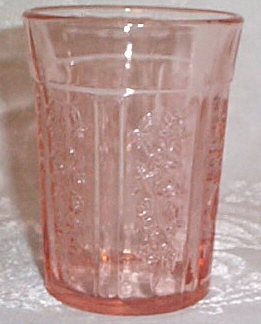National Depression Glass Association
Preserving America's Glass Manufacturing Heritage
A Depression Glass Primer
by Christine Nagy
Depression glass is the term to describe the machine made
glassware that was produced from the late 1920's through about
1940. Machine made glassware, as opposed to the fine hand finished
glassware that came before, was marketed to the less affluent
housewife. This glassware was produced in huge quantities, often
transported by  trainloads, to the various markets. It was was
produced in a rainbow of color..pink, green, yellow, amber, pale
blue, clear and also ruby red and deep cobalt blue.
trainloads, to the various markets. It was was
produced in a rainbow of color..pink, green, yellow, amber, pale
blue, clear and also ruby red and deep cobalt blue.
It should be noted that machine made, mass-produced glassware was not intended to be perfect ... there are many flaws to be found in depression glass...bubbles, inclusions, straw marks, slightly irregular shapes, variations in color; all may be present, which should not diminish the value of the piece. However, obvious cracks, chips, or other damage is not normal and devalues the piece greatly. Foggy, or cloudy, water stained glass is known as "sick" glass and is not salvagable at all.
After the crash of 29, this glassware offered a bit of brightness and hope for the future, to the average housewife. It was priced very reasonably, often for just a few cents. What made this even more attractive, was that many companies either packaged a small piece of this glass in with their product, or it was handed out at the counter when the specified product was purchased. Dish night was popular at the local movie houses, which gave away different pieces each week; many women aquired entire sets in this manner, Companies use this as a marketing tool to encourage purchase of their product. Westinghouse gave sets of refrigerator water jugs and leftover dishes when a refigerator was purchased, Cannister sets and shakers were givaways with kitchen cabinets of the day and even entire sets of this brightly colored glass was a premium with dining or kitchen sets.
There were many companies which produced this very affordable glass. Hocking, Federal, Jeannette, MacBeth-Evans, to name a few. Patterns which had plain centers were found to scratch easily, thus many patterns had more intricate designs, added to the molds later in the production of the pattern. Collectors usually favor the "all-over" design, in these patterns.
There are as many different types of collectors, as there are patterns of Depression Glass. Some concentrate only on one pattern, in one color. Others, collect all patterns by a certain company; others collect just cups and saucers, sugars and creamers, pitchers or candy dishes ... well you get my drift!
Reproductions have caused great upheaval in the depression glass market, but there are ways to protect yourself from purchasing repros. First and foremost, educate yourself as to whether or not the item, you are collecting has been reproduced ... there are always telltale signs, and knowledge of these, can help you from mistakenly purchasing a reproduction. There are many good reference books available, both in local bookstores, and in most libraries. Then know your dealer! A reputable dealer is one who has a good knowledge of their product and can give detailed info or direct you to where you can find out more. If a dealer is selling many reproductions, such as glassware in a color never produced in that color, beware ... many such reproductions have a "greasy" feel to them, and the pattern may be very faint, lacking the detail of the original.
Collecting depression era glassware has something for everyone ... it can be just a few accent pieces, to add color to your apartment. It can be collecting to fill in a set left by a favorite relative, or it can lead to a huge collection encompassing most every pattern and color. The thrill of the hunt is what makes it satisfying for many collectors.
Webmaster's NOTE: The NDGA wishes to thank Christine Nagy for her permission to use this article.